(Kadamba Kanana Swami, 26 April 2016, Radhadesh, Belgium, Vyasa Puja Address)
 I was fortunate; I got the mercy of the dhama, of a world dedicated to Krsna. Of course, the external layer of Yogamaya covers the dhama but below it, there is a deeper level. When we go to Radha Kund, we may see amazing things but we do not see jeweled swings on the four corners. We do not see what Krsna das Kaviraj Goswami saw in Govinda Lilamrta. When he describes Radha Kund, it is different than what we are seeing. But even then, in that external layer of the dhama, so much of the spiritual world comes through. It was clear to us who were serving there, it was clear that we must be transparent to the nature of the dhama. With our own false ego, with our own desires, with our own activities, we should not obscure the transcendental nature of the dhama.
I was fortunate; I got the mercy of the dhama, of a world dedicated to Krsna. Of course, the external layer of Yogamaya covers the dhama but below it, there is a deeper level. When we go to Radha Kund, we may see amazing things but we do not see jeweled swings on the four corners. We do not see what Krsna das Kaviraj Goswami saw in Govinda Lilamrta. When he describes Radha Kund, it is different than what we are seeing. But even then, in that external layer of the dhama, so much of the spiritual world comes through. It was clear to us who were serving there, it was clear that we must be transparent to the nature of the dhama. With our own false ego, with our own desires, with our own activities, we should not obscure the transcendental nature of the dhama.
And such is the Hare Krsna movement – it is an extension of the dhama as Narottama dāsa Ṭhākura mentioned golokera prema-dhana, hari-nāma-saṅkīrtana. This entire Hare Krsna movement is basically the activity of the spiritual world and of the nature of the spiritual world. The purpose is to be residents of the spiritual world, gradually we have to change!
I have given my example of the person who takes a step forward, who stretches his leg and goes from the material world to the spiritual world. First, all the weight is on one leg – the leg in the material side. So we are reaching out to the spiritual world but all the weight is still on the leg in the material side. The spiritual world appears theoretical, the spiritual world appears far away – beautiful and certainly attractive, like a dream. Yet again and again, we hear about Krsna… we hear about his pastimes… we hear about endless cowherd boys… unlimited cowherd boys and unlimited calves and cows… we hear about the gopis… we hear how when Krsna goes to the forest the gopis all remaining behind in separation… we hear that the tallest gopi is put on a tower of the palace of Mother Yasoda in the lookout post and in the evening finally, “Some dust! Dust! Duuust!” Hmmm, the hooves of the calves and cows are throwing up dust and Krsna is returning! We hear these things again and again. Different stories, different descriptions and little by little, it starts to sound familiar.
 We engage in service and in this engagement in devotional service, we have to put our own material desires aside. There is just no time! One who is busy in devotional service has no time for material things. In this way, everything just gradually changes and the weight goes from the material leg towards the spiritual leg, the weight now comes on the spiritual side and eventually we become residents of the spiritual world.
We engage in service and in this engagement in devotional service, we have to put our own material desires aside. There is just no time! One who is busy in devotional service has no time for material things. In this way, everything just gradually changes and the weight goes from the material leg towards the spiritual leg, the weight now comes on the spiritual side and eventually we become residents of the spiritual world.
īhā yasya harer dāsye, karmaṇā manasā girā, nikhilāsv apy avasthāsu, jīvan-muktaḥ sa ucyate (Bhakti-rasāmṛta-sindhu 1.2.187)
We become jivan muktas (liberated) even though we are within this body, even though we are in this material world, we become liberated. It is not a mystic thing, it just happens, it is very practical. Srila Prabhupada was very practical. That is for sure. “Practical” generally speaking refers to “down to earth”. Someone said that I was practical and it is tiring to be practical, I tell you. It is better to be spaced out in some way. I always see all these people (yawning) totally in bliss and they don´t see that there is a fire somewhere. But I see it! I always see the fire, I always see the flower pot that is about to fall on someone´s head or something. God, it is tiring to be practical!
But Srila Prabhupada was practical and Srila Prabhupada showed that practical also means spiritual because he showed that actually as we step towards the spiritual world and as the weight shifts towards the spiritual leg then the entire world changes into the spiritual world, then we realize actually that the spiritual world is not far at all, that the spiritual world is here. We are already there! We are simply there. It is just a matter of an adjustment of consciousness. It is not a long journey all the way to the spiritual world. No, we are already there.
We want this kind of reality, to manifest the spiritual world here. This is our business together!
Transcribed by Tattvavati dd

 By Lakshman das
By Lakshman das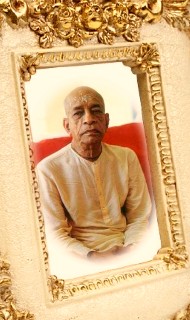 By His Divine Grace A.C.B. Swami Prabhupada
By His Divine Grace A.C.B. Swami Prabhupada





















 By Chirag Dangarwala
By Chirag Dangarwala By Giriraja Swami
By Giriraja Swami

































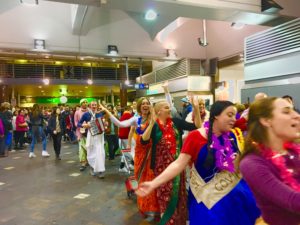
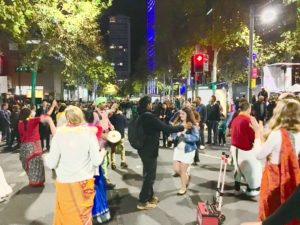
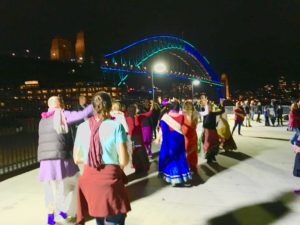
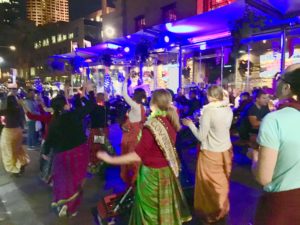

 By Giriraj Swami
By Giriraj Swami By Kesava Krsna Dasa
By Kesava Krsna Dasa By Suresvara Dasa
By Suresvara Dasa